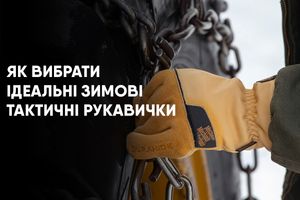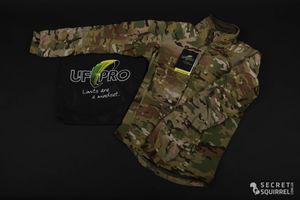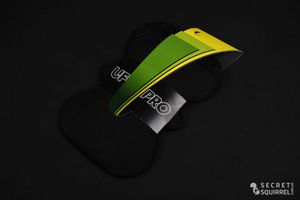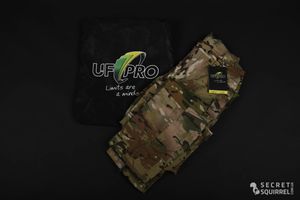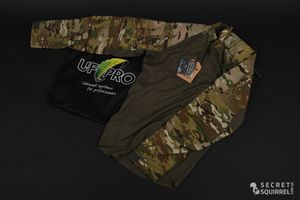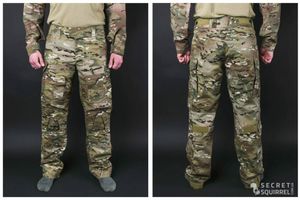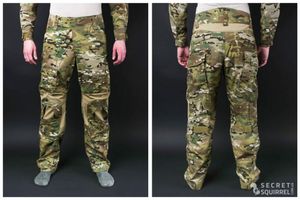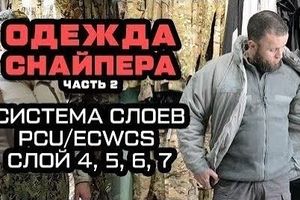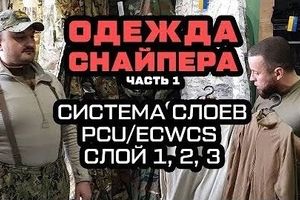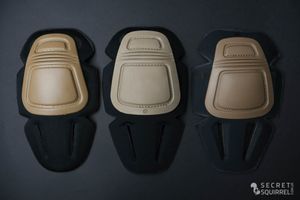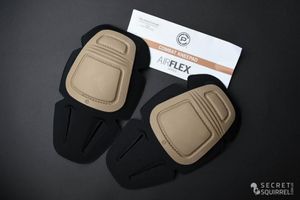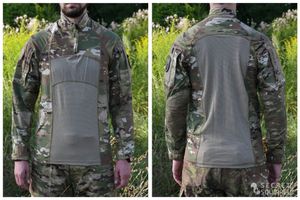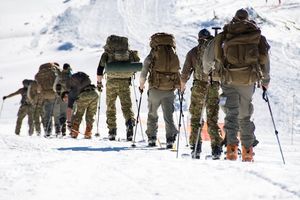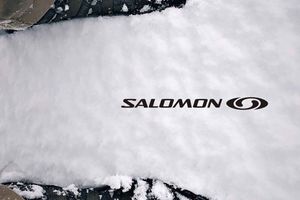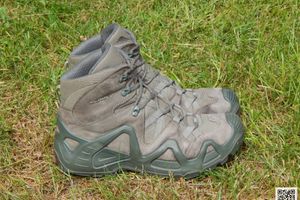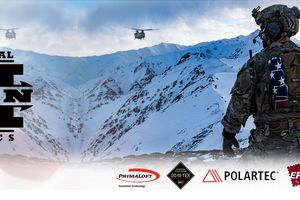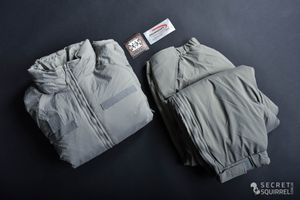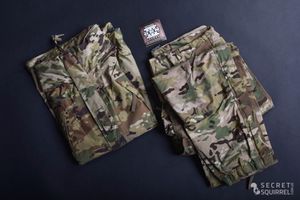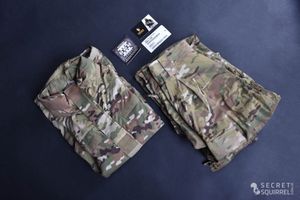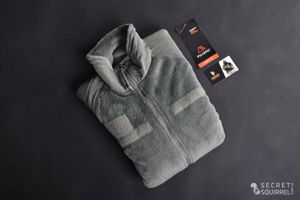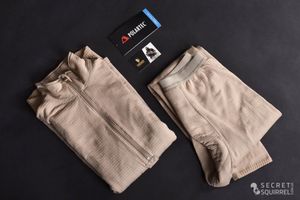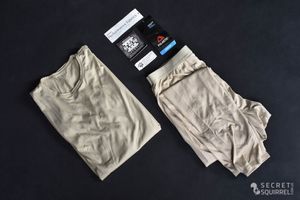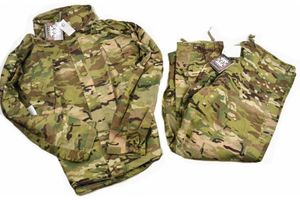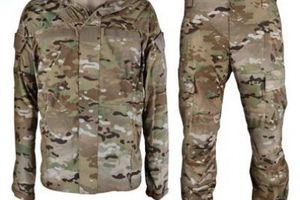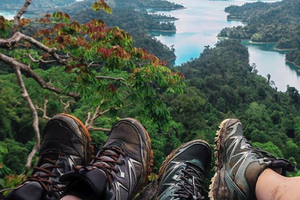At the beginning of the war in Afghanistan, US forces were in extreme cold conditions, and the clothing systems they operated at that time were not suitable for such conditions.
In 2002, US Army Master Sergeant Tony Pryor, who later received a silver star, made a phone call from the Hindu Kush (a mountain system in Afghanistan and Pakistan) to Rick Elder, a specialist on the Natick Soldier Systems Special Projects team. Pryor demanded that Natick Soldier come up with a better solution to keep the soldiers in such conditions.
An experienced team has been assembled to tackle this problem, including Chief Petty Officer Scott Williams, a former officer in charge from the Naval Special Warfare Detachment based in Kodiak, Alaska, where the newly minted seals are trained in cold weather. The experienced team also included civilians with vast experience in cold conditions, such as Mark Twiet, and a year later they developed and released an interchangeable clothing system called PCU, or Protective Combat Uniform, which provided comprehensive cold weather protection options for the military. ...

The PCU system is divided into seven "layers" that need to be clean, it is not necessary to wear all seven layers at the same time, they need to be combined with each other to protect against different weather conditions. The PCU system consists of sixteen different garments, each providing a different function.
PCU backstory - ECWCS and Natick Soldier
In 1949, Congress approved the creation of the Natick Soldier Systems Center (often referred to as "Natick Army Labs"). In 1952, construction began on facilities that will become the main research center for technology created by the United States Army in the coming decade.

By the 1980s, Natick was developing what would become the ECWCS (Extended Cold Weather Clothing System), which began to be issued to soldiers in 1986. While ECWCS will be modernized by new generations many years later, these changes will not reflect the pace at which civilian clothing for cold conditions has evolved. Because of all this, that very Pryor phone call was made from the mountains of Afghanistan.
The development of the PCU system was both a radical rethinking of the first prerequisites underlying the creation of such a clothing system, and the opportunity to apply new revolutionary materials, which, according to civil mountaineering, radically changed this area.
Mark Twight - PCU Godfather
By the time Mark Twight joined the PCU project, he already had twenty years of experience in several continents as a mountaineer. He has also been a technical consultant for outdoor clothing manufacturers such as Patagonia, for whom he helped develop their now ubiquitous Regulator system.
The video above was taken from a larger PCU training video that was released many years ago, featuring Mark Twight and his team.
Protective Combat Uniform

The PCU Natick project is a multi-tiered system that helps protect the soldier from cold and wet weather, from 7 degrees to -45.5 degrees Celsius. The system is lightweight and highly compressible, it can reduce the amount of space that is required when loading, and also reduces the overall weight carried by the soldier carrying it.
The use of the PCU system depends on the characteristics of the human body and its mission. Although some basic guidelines are included in the user manual as sample data for various specific weather conditions, it is important that each user experiment with different combinations so that he can determine for himself what works best for each situation. Different body structure and different metabolism, which is why there will be different combinations of levels for each person.
The fundamental prerequisite for the PCU system is adaptability. Mission planning is imperfect as situations change rapidly and weather forecasting is an imprecise science.
The expected atmospheric conditions may be completely wrong. The ability to adapt to changes in external or mission conditions can potentially mean the difference between life and death, or mission success or mission failure.
Remove moisture!
The PCU system consists of synthetic materials that do not retain water. They can become damp, either from external moisture, or moisture generated by activity (sweating), they are designed to dry quickly. The use of these materials stems from the experience of Scottish climbers who have determined that it is impossible to stay completely dry. As a result, the main strategy was to put on materials that would lose water as quickly as possible.

This thought process led to the insertion of soft shell materials previously developed by Snugpak. Unlike the earlier ECWCS system, which relied on insulation under the Gore-Tex hard shell, the PCU system relies on the use of a more breathable, albeit less “waterproof” outer soft shell.
The Gore-Tex membrane is made of a porous Teflon film that does not allow water to pass through it in a liquid state, but at the same time allows water to pass in a vapor state. In addition to the soft shell layer, insulating layers are also used that cannot hold water, which results in more efficient water-moisture on the outer layers.
How it works
The PCU system places an emphasis on durability and functionality and, as described, is the best cold weather clothing system ever created. The basic theory of operating this system requires some understanding of physics, so buckle up!
In any clothing system, moisture will penetrate into or out of the system due to the temperature and pressure difference between the two zones, a phenomenon called "microclimate". Simply put, it is the area inside the garment between the human body and the "macroclimate" environment outside the garment system.
When the temperature in the macroclimate is lower than the temperature in the microclimate, moisture is removed from the body, to the outside of the clothing. As the temperature difference tends to equalize, water vapor is forced out. In the case of liquid sweat, the capillary properties of the insulating layers perform the same task as the steam moving towards the macroclimate. When the humidity is the same inside and outside, water stays inside the system.

Although Gore-Tex is still part of the PCU system, its use is limited to specific conditions in which the moisture outside the system is significantly higher than the moisture inside the system. The level 5 soft shell is a more important part of the PCU due to various conditions that Gore-Tex does not fulfill:
- If the pores of the Gore-Tex fabric become saturated, moisture will not evaporate from the layers;
- If the inner layers become cold and the moisture inside freezes, then the inner layers “stick together” with the insulating layer, this prevents steam and moisture from escaping outside the system;
- If the user loses heat while in a static position, instead of generating heat in motion, the rate of moisture transfer through the layers will be lower, which will significantly reduce the efficiency of its removal.
The level 5 soft shell is water resistant, but not waterproof. It is made, like all other elements of the PCU system, from hydrocarbon materials, also called "plastics", which cannot absorb water. The soft shell is also windproof, creates a significantly lower vapor barrier than Level 6 Gore-Tex and requires less pressure to wick moisture out of the entire system.
When combined with clothing at different levels of the system, the goal is always to get the dew point away from the body and into the macroclimate. The PCU system is a self-drying soft shell system reinforced with hard components that dries quickly when it gets wet.
Users are advised to get wet before beginning system testing to see how quickly water is displaced from the system. After immersion in the system, the user begins to move, and the clothing immediately next to the skin dries in about 15 minutes, and the entire clothing system in 60 minutes.
Despite these statistics, moisture due to gravity can collect in layers towards the waist and wrists. Despite this, PCUs remain preferred over systems that remain moist and retain water. Cotton, for example, absorbs almost 100% moisture and retains it indefinitely. Remember the old street adage: "Cotton is rotten".
Movement and immobility
The PCU is designed to provide comfort while on the move, when your body generates heat under the influence of physical activity, and when the body loses heat when stationary, the PCU can be adjusted to stay warm and dry.
This is accomplished by adding appropriate levels of garment system items. For example, if you move for several hours using the 4th windproof layer, together with the 1st and 2nd insulation and 5th soft shells, and then have to stop, then you can take out your jacket of the 7th level and put on it is on top of the rest of the layers to maintain heat, while removing moisture from your body.

The goal of the PCU is to stabilize body temperature, which is accomplished through increased breathability and overall system enhancement. Suppose, after having remained motionless for several hours, you suddenly need to start moving again, then you simply remove and pack your jacket and / or pants of the 7th level and begin to move, again generating heat due to physical activity, which will keep you warm.
There are several different types of heat loss, which we will discuss below for completeness.
The loss of heat by evaporation occurs due to moisture evaporating from the body, which causes a rapid cooling effect, sometimes called "flash off".
Convective heat loss as a result of exposure to cold air, wind moving over the surface of the body, the heat goes away. This is called the chimney effect.
Conductive heat loss occurs from direct contact, in which heat is transferred from an object warmer (you) to an object colder (stone or cold ground on which you sit).
Heat loss caused by IR release when the sun goes down and you no longer bask in its direct rays.
Finally, there is heat loss, which is a combination of evaporation and convection heat loss. It does this by inhaling very cold air that circulates inside your body before you exhale, facilitating heat loss.
Levels

From left to right: Level 1A, Level 1, Level 2
Level 1A / Level 1A - consists of a short-sleeved T-shirt and underpants, worn on the body (like underwear, but wearing it with the PCU is unnecessary), the main function of absorbing moisture from the body and output to the upper layers.
Level 1 / Level 1 - consists of a shirt with long sleeves and pants, on the body, as well as underwear, absorbs and removes moisture into the upper layers. The fabric composition for Levels 1 and 1A is the same, but depending on the manufacturer it may differ, for example, for Sekri Inc .: 97% Polyester, 3% Silver Coated Nylon.

T-shirt with long sleeves Level 2, Sekri Inc.
Level 2 / Level 2 - Consists of a jumper and pants that wick moisture away from the skin, pushing it out. Layer 2 fabric composition, manufacturer Sekri Inc .: 93% Polyester, 8% Spandex.

Left to right: Level 3, Level 4, Level 5
Level 3 / Level 3 is a fleece jacket that is very warm and dries quickly. However, it is usually not ideal in active situations due to the large amount of heat it retains, which can lead to overheating when the user is actively moving and generating a lot of heat. Consists of Polartec fleece - 100% Polyester.

Windbreaker Level 4, Orc Ind.
Level 4 / Level 4 - Consists of a thin windbreaker that is designed for use inside the system, although it can also be worn as an outer layer. Typically, Level 4 is worn under other layers and helps retain 300% more heat than without. It is ideal for escape and evasion situations as it is very compact and can be rolled up and placed in a pants pocket. It is less durable than a Level 5 Soft Shell, but is also not designed for high abrasion situations, such as when crawling on rocks or getting in and out of your car frequently. It is often worn as an underlayer under a soldier's camouflage uniform, used in a helicopter or in other situations where there is a strong wind. Composition: 100% Nylon.

Level 5 Jacket, Orc Ind.

Level 5 Pants, Orc Ind.
Level 5 / Level 5 - Soft Shell Jacket and Pants are the cornerstone of the PCU system. In cold weather, the L5 jacket and trousers replace the wearing of camouflage uniforms, the zippers of the pockets are protected from rain and wind, the hood can be used both under the helmet and over the top.

Bottom of the trousers Level 5, pictured showing paracord holes, manuf .: Patagonia
The Level 5 pants can be fitted with a paracord and temporary gaiters to keep snow out of the wearer's shoe. Composition: 100% Nylon.

From left to right: Level 6, Level 7A, Level 7
Level 6 / Level 6 - Gore-Tex Hurd Shell jacket and trousers for wearing in heavy rain. Level 6 clothing is breathable, albeit less than level 5. The size is specially designed to be worn over Level 5. 3/4 of the length of the L6 pants have zippers on the legs, which allows them to be worn over boots and boots with relative ease.

Level 7 Jacket, Orc Ind.

Jacket Zipper Level 7

Level 7 Jacket Mesh Pocket
Level 7 / Level 7 - Consists of a jacket, vest, and trousers that can be worn over other PCU components. Level 7 clothing is waterproof and breathable. The L7 Type 1 jacket is the same size as a regular jacket and has mesh pockets for quick drying of gloves and socks inside the jacket.

Jacket L7 Type 2
The L7 Type 2 jacket is focused on mobility, designed for a soldier with body armor and a light assault backpack, equipped with two closure systems: Velcro and a zipper, also has a drawstring in the lumbar region for tightening to be more similar to the L7 Type jacket

Vest L7A, Orc Ind.
The L7A vest is designed to be worn under an L7 Type 1 or Type 2 jacket to provide additional insulation at temperatures down to -50 degrees.

Pants L7

Pants L7
Finally, the L7 pants are designed to be worn over other insulation layers. The knee area and 5th point are reinforced with abrasion-resistant materials, and the bottom can be converted into a gaiter like the L5 trousers.
Fit and finish
The fit of the PCU system comes down to the average size of the SOF (Special Operations Forces) personnel, which means that individual garments can be slightly larger than their civilian counterparts. This is because the average SOF employee is slightly stronger and larger than the average civilian.
However, companies like Beyond Clothing have the ability to tailor different garments to any individual in a process that starts by taking some complex measurements of that individual before being built based on custom specifications. As a result, the PCU can be made suitable for anyone, big or small.

In general, the PCU system tends to fit a little more snugly than some outdoor clothing and even more than a standard military uniform. The garment fit is designed to complement the layers of the various system elements while providing maximum mobility through stretch fabrics such as those used in L5 soft shells. The weapon will usually also be slightly farther to accommodate use and transport in any given position, from standing to lying down.
Planning and packaging
For the military, the PCU system comes in one large bag full of clothing, garment use and care documents, and a QuickPoint Visual User, which serves as a valuable reference point in helping the wearer know which atmospheric or mission conditions work with a particular a combination of specific PCU levels.

The system is best used in a variety of combinations, which means you don’t have to put layers on top of each layer until you have put on all seven layers. The conditions of your operating environment and the requirements of your mission will determine not only what you wear, but what you put in your backpack for later use. The windbreaker (Level 4), in particular, is a very versatile garment, it allows you to maintain a more stable internal temperature as well as reduce friction between layers of insulation.
In addition, the axiom of dressing smarter, not more, is at work; this means that just a couple of layers can be more beneficial than all 7 layers. What may work for most people may not work for the individual, and there is no personal experience in determining what works best for any situation.
When preparing for a journey or mission, you don't want to just stuff it all into your backpack. Although these garments are lightweight individually, the overall weight is not small. Knowing what you might need and what you won't be using will help you decide what you need.
Preparation also includes knowing where to put the garments inside your backpack. If you're heading for a mountainous environment and you know it's going to be cold and dry, you probably want to tuck your parka or L7 jacket at the top of your backpack, for easy access. When you stop moving, you'll want to crawl into the top of your backpack and pull out your jacket right away, without digging through a pile of other things to get to it. As soon as you stop moving and start to stand still, move from active to static scenario, you start to lose heat.
At the same time, you may want to dress less on yourself when you hit the road, despite the fact that you may be cold. Once you start moving, you start to get warm. Choosing the right insulation layers, especially torso insulation layers, is the key to your comfort and efficiency.
Accessories
The PCU is an excellent cold weather clothing system, but it is not complete. It does not include gloves, mittens, hats, socks and shoes. Obviously there are many options for all of these items; in peacetime, the choices may be even more numerous, but in the war world, the favored choices for them are still strong. Companies like Outdoor Research have a fantastic variety of mittens and hats for government officials and civilians.
There is another item that complements the Tier 7 mechanism previously made by Sierra Designs, which as far as we know is no longer in production, but worth mentioning. Known as the Elephant's Foot, this piece is a 3/4 body-length sleeping bag with braces and an opening bottom that uses Primaloft insulation to effectively double the insulation.

The Elephant's Foot served as a sleeping bag when it was used alongside the L7 jacket and pants, but it also allowed you to easily open the bottom, lift it up and do your thing without taking it off. It also provided quick mobility in case something went horribly wrong while sleeping. We have confirmed with the help of Sierra Designs that they no longer make this part, but it can always appear on the aftermarket.
Who makes this outfit?
Since 2002, a number of manufacturers have entered into federal contracts to manufacture specific items from the PCU. The system has undergone changes and modifications, over time was divided into "blocks" or generations. No company had a PCU contract for its entire life, although some companies made a contract and then held it again. ORC Industries, Patagonia, Beyond Clothing, Halys, Wild Things Gear, Propper, Blackhawk and others have all produced some or all of the PCU systems since its inception.

In this case, the evolution of the PCU can be observed in two primary generations. The first, duplicated block 0 (shown above), was released in early 2003. Unit 1 began production after the improvements were approved in 2006 (shown below).

Block 2 details have since been released to Soldier Systems by Editor-in-Chief Eric Graves back in early 2012 and reflect what is currently being released. The Block 2 included in this release are Tier 8 parts, which is just placeholder for future use, not the currently produced tier of clothing. Also mentioned is the Level 9 Combat Uniform, which can be seen as a more modern and modern version of the traditional BDU (Combat Uniform).
The changes between blocks are numerous and at the same time, to a large extent, blocks 0 and 1 still resemble each other. Block 2 includes notable changes to certain fabrics, clothing levels, and even additional garments in general, such as Levels 3a and 3b.
Where can you get the PCU?
ADS is currently selling the PCU system to approved government buyers. Patagonia and Beyond Clothing are actively producing clothing systems. Other than that, civilians can buy levels directly, although Patagonia can only be bought mostly through eBay or other similar places.
For the most part, Patagonia downplays the fact that they make PCUs, which can lead to unwanted feedback from their customer base.
Some Block 0 components can still be purchased from ORC Industries, although they no longer manufacture clothing. Wild Things Gear already had some levels in stock when they signed with the PCU, and Defense Outfitter is the place to go for Halys or Sekri PCU, but they've pretty much dried up. Naturally, individual items from different iterations of the PCU appear on eBay from time to time. Ontario Geardo also maintains a large list of various PCU online stores on its website, but again, most of them no longer have clothing in stock.
While the options currently on offer tend to be a little more expensive, buying equivalent items from outerwear manufacturers will also cost you quite a bit. As an added benefit, the entire PCU system, as a result of the Berry amendment, is manufactured entirely in the United States of America.
The last important mention about the choice is that the PCU is made in layers, which means that if your size is Medium, then your size for each layer will be Medium. The increased layer mass is attributed to each part, so there is no need to increase the size on the next layer.
There is no doubt that the PCU system will continue to be revised and improved over time, and these changes will appear in all other military clothing systems. The ECWCS system, currently in its III generation iteration, has changed a lot over time and is now having a big impact on the PCU system.
I hope you learned a lot about Protective Combat Uniform and we encourage you to share any information in the comments below about the PCU's history or buying, online resources that may help others.
Sources:
- SSC-Natick – Uniform Covers “Special” Field Request
- Backpacker – Stone Cold Campers
- ADS – Environmental Clothing Systems
- Soldier Systems – Block 2 Preview
- U.S. Navy Photos by Mass Communication Specialist 2nd Class Erika N. Manzano/Released
The article was prepared by Vasiliev Stepan
Article about: PCU BLOCK 2 (II). New USSOCOM clothing concept.
Original Source: https://www.itstactical.com/gearcom/apparel/comprehensive-guide-protective-combat-uniform/
Source: https://vk.com/@vasilyeu_stepan-pcu-zaschitnaya-boevaya-uniforma-istoriya-sozdaniya-sistem
Author: Vasiliev Stepan











































































































































